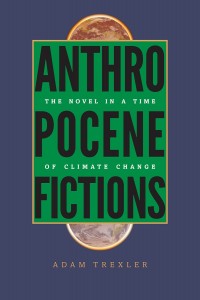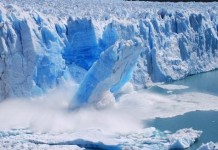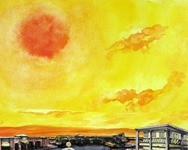 It’s not everyday that a 288-page academic book arrives in my mailbox, especially a big fat academic tome that taxes my failing eyesight and hardly fits into my apartment building’s mail slot.
It’s not everyday that a 288-page academic book arrives in my mailbox, especially a big fat academic tome that taxes my failing eyesight and hardly fits into my apartment building’s mail slot.
But I’m glad this one made it safely across the seas from where it was published by the University of Virginia Press. It will be released soon, April 20, and the big reviews will start up soon after. This article is not a review.
The author of Anthropocene Fictions is Adam Trexler, an independent scholar who went to college in Maryland and got his advanced degrees in England.
Now he makes his home in Oregon, writes big nonfiction academic books about climate change and works for a company that thinks about ways of making gold-valued paper bills with a Portland firm he works for called Valaurum.
Trexler’s accomplishment? He’s single-handedly taken a monograph he published online four years ago and turned it into an important nonfiction book. We’ll just have to wait to see what the critics and book reviews say later on this month and over the summer.
Subtitled “The Novel in a Time of Climate Change,” the book studiously looks at 150 sci-fi and cli-fi novels over the past 40 years or so.
I asked Trexler about this book last year while he was still in the process of editing it and he told me, ”Climate-change literature may warn about the dangers of disastrous global warming, adding to the climate debate. Its more important function is to help us understand what it means to live in an era when climate change is already upon us, when its disastrous effects are accumulating, and when we seem unable to address it in any comprehensive way.”
I’ve read the book, and from the 15-page introduction itself, I’ve come up with 15 ”talking points,” to walk you through some key themes.
1. From the year 2000, a group of geologists led by Paul Crutzen started to point out that the present period of Earth’s history could be called the ”Anthropocene,” meaning a period heavily impacted not by only nature but by man himself.”
2. When did the Anthropocene period begin? James Watts invention of the steam engine (1784)? The increase in ground radiation from nuke tests in the 1950s? Or the beginning of human agriculture some 12,000 years ago?
3. The term ”Anthropocene” has appeared already in 200 peer-reviewed articles and has even become the name of an academic journal.
4. The impact of burning fossil fuels has been studied for over 100 years already. In 1896, Svante Arrhenius made the first calculations.
5. Why is the book is titled “Anthropocene Fictions” and not ”Climate Change Fictions,” for example? Trexler tells all.
6. Trexler first got interested in cli-fi novels and movies in 2008.
7. Cormac McCarthy’s novel “The Road” was one amazing read but it was not really about climate change or global warming. In fact, it was about a comet strike on Earth and the aftermath, according to McCarthy.
8. The journalist press only recently began to recognize the cli-fi term for novels and movies, starting in 2013 with an NPR radio segment by Angela Evancie.
9. Andrew Dobson in England has called for the creation of cli-fi novels, but said the cli-fi novel had yet to be written.
10. “Rather suddenly,” since 2013 and 2014, some media outlets worldwide began to talk about the cli-fi term and meme, among them TeleRead, the Guardian, the Sydney Morning Herald, the Associated Press, Reuters and the New York Times “Room for Debate” forum.
11. Trexler notes on page 8 of the introduction: “Perhaps prompted by Dan Bloom’s coinage ‘cli-fi,’ [global media outlets] began reporting that climate change had spurred the creation of an entirely new genre of fiction.”
12. The central probe of the book is a study of 150 cli-fi novels past and present and how climate change and and all its “things” have changed the ”capacities” of recent novels and movies.
13. The Anthropocene Age challenges sci-fi’s technological optimism, its general apathy toward life sciences and SF’s ”patriotic individualism.”
14. The book moves between ”the overview of groups of novels” and “a close reading of exemplary [cli-fi] texts.”
15. Now there are cli-fi novels from a wide variety of nations, including Canada, Australia, the U.S.,
Taiwan, Finland, Germany, Iceland, Spain and Holland. However, cli-fi is not the result of a literary ”school” of related authors, and no single unitary idea or influence connects all cli-fi.


































Added it to my Amazon wish list (as if it isn’t long enough, already. Sounds fascinating, even if I will never, ever use the term “cli-fi.”
“13. The Anthropocene Age challenges sci-fi’s technological optimism, its general apathy toward life sciences and SF’s ”patriotic individualism.” ”
Someone obviously isn’t that well-read in science fiction…
Yes Steph B, even Star Trek found a way to contribute when they discovered the disruptive effects of putting “the pedal to the metal” while engaging their warp drives. See: http://en.memory-alpha.org/wiki/Speed_limit